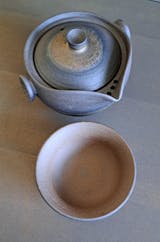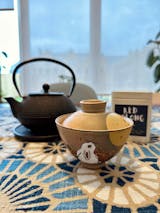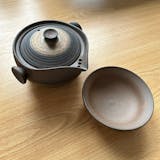
The Ultimate Guide to Gaiwans: How to Use This Traditional Teaware
Share
The gaiwan, a staple of Chinese tea culture, is a versatile and elegant brewing vessel that allows tea lovers to fully experience the flavours and aromas of their favourite teas. Whether you're a seasoned tea enthusiast or just beginning your journey into traditional teaware, this guide will teach you everything you need to know about using a gaiwan properly.
What is a Gaiwan?
A gaiwan (盖碗), meaning "lidded bowl," consists of three parts:
- The bowl – where the tea leaves are placed and brewed.
- The lid – used to control the pouring and steeping process.
- The saucer – protects your hands from heat and provides stability.
Gaiwans originated during the Ming Dynasty and have been used for centuries as a tool for brewing delicate teas. They are particularly popular for green, white, oolong, and pu-erh teas, as they allow the leaves to expand fully, enhancing the taste and aroma.
Why Use a Gaiwan?
Gaiwans offer several advantages over teapots:
✔ Pure Flavour – Unlike Yixing clay teapots, which absorb flavours over time, porcelain or glass gaiwans retain the tea's true taste.
✔ Quick Steeping – Ideal for multiple infusions, allowing you to enjoy the evolving flavours of the tea.
✔ Full Control – The lid lets you adjust steeping time and control how much tea is poured.
✔ Aesthetic Experience – The open design allows you to observe the tea leaves unfurling beautifully.
How to Use a Gaiwan: Step-by-Step Guide
1. Preheat the Gaiwan
Pour hot water into the gaiwan and swirl it around to warm the bowl. This helps maintain the brewing temperature. Discard the water before adding tea leaves.
2. Add Tea Leaves
The amount of tea depends on the type and personal preference, but a general guide is:
- Green/White Tea – 3-5g
- Oolong Tea – 5-7g
- Pu-erh Tea – 5-8g
Unlike tea bags, loose leaves need space to expand, and the wide bowl of a gaiwan allows this to happen beautifully.
3. Rinse the Tea (Optional)
For oolong and pu-erh teas, a quick rinse helps awaken the leaves. Pour hot water over the leaves, swirl briefly, then discard the first infusion.
4. Steep the Tea
Pour hot water over the leaves and cover the gaiwan with its lid. Steeping times vary:
- Green/White Tea – 30-60 seconds
- Oolong Tea – 20-40 seconds
- Pu-erh Tea – 10-30 seconds
Since gaiwans are designed for short, multiple infusions, increase the steeping time slightly with each additional brew.
5. Pour the Tea
Hold the gaiwan with your thumb and middle finger gripping the rim, while your index finger rests on the lid to keep the leaves in place. Tilt the gaiwan slightly and pour the tea into a fairness cup or directly into teacups.
6. Enjoy and Re-Steep
Savour the tea and re-steep the leaves multiple times, adjusting the steeping time as the flavours evolve.
Tips for Mastering the Gaiwan
💡 Practice holding it – Gaiwans can be hot! Try gripping it confidently to avoid spills.
💡 Use a fairness pitcher – This helps distribute the tea evenly if serving multiple people.
💡 Experiment with temperatures – Some teas, like green tea, need lower temperatures (75-85°C), while oolongs can handle hotter water.
Choosing the Right Gaiwan
Gaiwans come in different materials, each with unique properties:
- Porcelain – The most versatile, retaining pure flavours.
- Glass – Great for watching the leaves unfurl.
- Clay – Absorbs flavours over time, similar to Yixing teapots.
Summary
Mastering the gaiwan takes practice, but once you get the hang of it, you’ll unlock a whole new way to appreciate tea. Whether you’re seeking pure flavours, multiple infusions, or a mindful brewing ritual, the gaiwan is an essential tool for any tea lover.
Explore our gaiwan collection now to elevate your tea experience!







